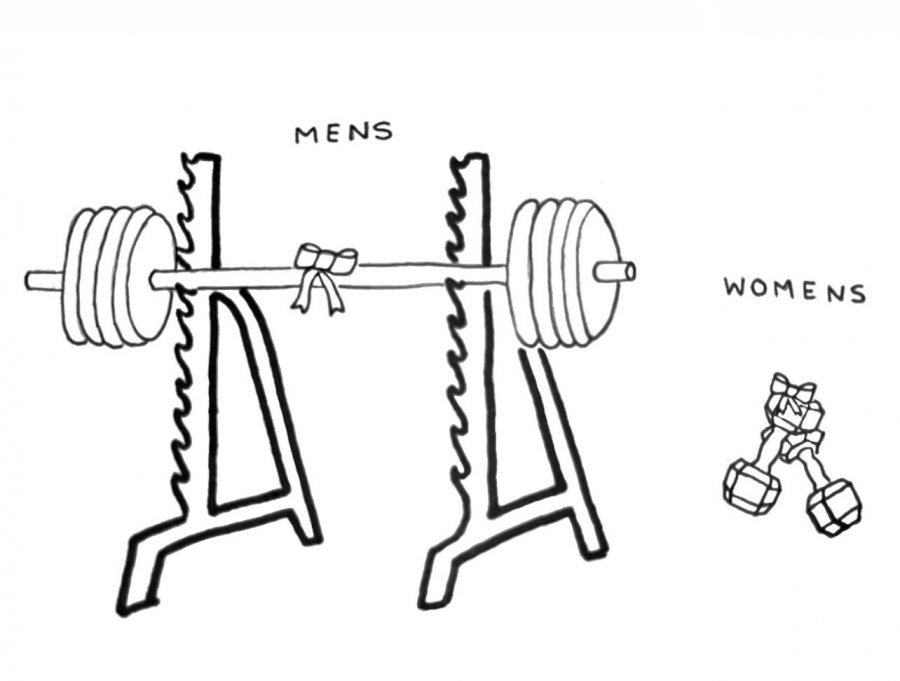Gender inequality in the NCAA needs to be benched
April 3, 2021
“Women’s sports are a joke. Women don’t lift weights. Women aren’t fast. Women can’t be strong. Women can’t be good at sports. Women’s sports are less important than men’s sports.” As a female athlete, I constantly hear these messages about women in sports. Female athletes have become so used to it that it feels like they cannot share their opinion on this topic without hearing misogynistic retorts. Misogyny continues to affect women across all areas, especially in athletics where women’s dedication and success are consistently overlooked, even by the very organizations that are supposed to be fighting for their equality, such as the National Collegiate Athletic Association (NCAA).
The 2021 NCAA March Madness Tournament is underway and the gender inequality between the men and women’s tournaments is startling. The extra weight room space, equipment, merchandise, food and acknowledgment that the men received this year show the organization’s bias against women. Gender inequality has been noticeably amplified by the NCAA at the tournament and it needs to come to an end because female athletes are just as hardworking and deserving as their male counterparts.
Stanford University coach Ali Kershner highlighted the imbalance between genders when her photos comparing the men and women’s weight rooms were spread through various social media platforms including Instagram, TikTok and Twitter. The picture of the men’s NCAA provisions shows their impressively enormous and fully equipped weight room filled with benches, numerous barbells with unlimited plates, several stationary bikes and stacks of dumbbells. The picture of the women’s provisions was pathetic in comparison; their so-called “weight room” consisted of six sets of dumbbells, a stack of yoga mats and a singular stationary bike. For the NCAA to believe that is all that women’s Division I basketball players need for the biggest, most popular tournament of the entire year is not only disrespectful to the women participating, but to all female athletes.
The discrepancies didn’t stop there. The NCAA also provided the male athletes with fully catered buffets, according to Alan Bishop, director of sports performance for men’s basketball at the University of Houston. The female athletes were excluded from this meal plan and, instead, were given limited boxed food options. The complete lack of merchandise and marketing female athletes received compared to men is also an evident disparity. When these imbalances were exposed, the gender bias was so obvious that it was a slap in the face for all female athletes.
Although the NCAA earns more money from men’s basketball, there is no reason women should receive fewer resources than men. The NCAA spends about a billion dollars on the NCAA March Madness tournament every year and most of the money is paid back from the men’s side of the tournament because of how many views they get, according to the American Gaming Association. The women’s side of the tournament isn’t as popular, but that does not mean it isn’t as important. The NCAA is also a nonprofit organization whose mission is to ensure that competition is fair and safe, according to the NCAA media center. If one of the association’s core values is fairness, they should be equally distributing resources amongst men and women athletes.
Additionally, the NCAA acknowledged the blatant gender inequality and stated that this issue had nothing to do with money, but rather the limited amount of space of the women’s facilities, according to Sports Illustrated. This statement turned out to be false. Sedona Prince, a player for the Oregon women’s basketball team, shared several videos throughout social media platforms exposing how large the facility was with plenty of extra space for more equipment. The NCAA clearly had no other excuse as to why the women didn’t receive the same amount of resources and opportunities that the men received.
After extreme backlash from the athletes and coaches at the tournament, the NCAA finally yielded the women’s basketball teams’ needs. The NCAA provided the women’s teams with a weight room that is almost identical to the men’s weight room, according to Prince. This improved the situation, but the weight room was only given to the final four, so the prominent gender imbalance still looms. If the NCAA could grant the women’s teams this space later on, why didn’t the association do it in the first place? Rather than constructing excuses, the NCAA needs to take accountability to move toward progressive change.
Female athletes need more authority in organizations like the NCAA to make sure decisions aren’t heavily biased toward the men’s tournament. Right now, the decisions for the March Madness tournament are in the hands of the selection committee for the NCAA, according to the NCAA media center. The selection committee board does have women representation, but all of the women are coaches and athletic directors. Having current or former female athletes, who have experienced gender imbalances, on the selection committee is a necessary solution. The female athletes could give an insider’s perspective on the decisions that the committee makes to ensure the tournaments will be proportionate for all genders before the event takes place.
Seeing the disrespect female athletes in the NCAA are forced to deal with is disappointing. Just because the men’s March Madness tournament is more popular does not mean that the women’s tournament should go overlooked. Female athletes deserve more acknowledgment and resources because of everything they have worked towards. It is time for the NCAA to understand that women need to be taken more seriously in sports and that they are just as worthy as men.
























